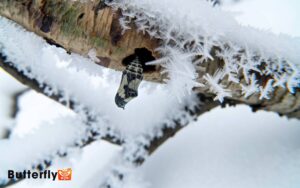5 Stunning Pictures of Tiger Swallowtail Butterflies
The Tiger Swallowtail Butterfly (Papilio glaucus), a striking lepidopteran, boasts a large wingspan of 8.9 to 14 cm and is easily identified by its vibrant yellow and black striped wings and distinct tail-like extensions. Males exhibit more pronounced yellow, whereas females may exhibit sexual dimorphism, presenting darker shades.
Often found in deciduous forests, woodlands, and river valleys, this species plays a significant role in pollination. The butterfly's complex life cycle involves complete metamorphosis.
For detailed insights into its ecological role and behavioral traits, a deeper exploration reveals fascinating aspects inviting further curiosity.

Key Takeaways
- The tiger swallowtail butterfly features striking yellow and black wings with a wingspan of 8.9 to 14 cm.
- It has bold black tiger stripes on yellow forewings and blue and orange eyespots on the hindwings.
- Females may exhibit darker coloration due to sexual dimorphism.
- Common habitats include deciduous forests, woodlands, suburban gardens, and river valleys.
Description and Characteristics

The Tiger Swallowtail Butterfly (Papilio glaucus) is characterized by its large wingspan, striking yellow and black coloration, and distinctive tail-like extensions on its hindwings.
Belonging to the family Papilionidae, this species exhibits sexual dimorphism, with females sometimes displaying a darker morph. Adult wingspans range from 8.9 to 14 cm, making it one of the larger North American butterflies.
The body is robust, with a black thorax and abdomen adorned with yellow spots. The forewings are elongated and angular, while the hindwings are rounded with 'swallowtails'—prolongations that resemble avian tails.
This butterfly is found in deciduous forests, woodlands, and river valleys, where its larvae primarily feed on the leaves of deciduous trees such as tulip trees (Liriodendron tulipifera) and wild cherry (Prunus serotina).
Color Patterns
Exhibiting a vivid interplay of yellow and black, the wing pattern of *Papilio glaucus* serves both as camouflage and a warning signal to potential predators. This intricate coloration is a hallmark of the species, playing an essential role in its survival. The forewings feature bold black tiger stripes on a yellow background, while the hindwings possess a blue and orange eyespot near the tail, adding to their visual complexity.
- Pattern Symmetry: The wings display bilateral symmetry, enhancing their visual appeal.
- Sexual Dimorphism: Females often exhibit a darker morph, mimicking the toxic *Battus philenor*.
- Adaptive Significance: Color patterns deter predators via Batesian mimicry.
These facets underscore the adaptive significance of their striking color patterns.
Habitat and Range

Papilio glaucus occupies a diverse range of habitats, including deciduous forests, swamps, and suburban gardens across North America. This species, commonly known as the Eastern Tiger Swallowtail, exhibits adaptability to various environmental conditions, thriving in both natural and human-altered landscapes.
Geographically, its range extends from the eastern United States to the Great Plains, and from the southern parts of Canada down to Florida and Texas. The butterfly prefers regions with ample host plants such as tulip trees (Liriodendron tulipifera) and wild cherry (Prunus serotina) for oviposition.
Microhabitat preferences include areas with abundant nectar sources, necessary for adult sustenance. The species' wide range and habitat versatility underscore its ecological resilience and evolutionary success within the Lepidoptera order.
Life Cycle
Understanding the life cycle of *Papilio glaucus* reveals the intricate processes that enable its survival and reproduction across diverse habitats. This species, belonging to the family Papilionidae, undergoes complete metamorphosis, encompassing four distinct stages: egg, larva, pupa, and adult.
- Egg: Females deposit spherical eggs on the leaves of host plants, ensuring offspring have immediate access to food upon hatching.
- Larva: Caterpillars, initially resembling bird droppings for camouflage, undergo several molts, growing and developing distinct coloration.
- Pupa: In this stage, the larva forms a chrysalis, undergoing significant morphological changes within a protective casing.
This cyclical process underscores the adaptability and resilience of *Papilio glaucus*.
Feeding Habits

The feeding habits of Papilio glaucus, commonly known as the Tiger Swallowtail Butterfly, are characterized by their preference for specific nectar sources.
These butterflies primarily feed during daylight hours, favoring flowers from families such as Asteraceae and Apocynaceae.
Their proboscis is adapted for extracting nectar from tubular flowers, including species like Asclepias, Buddleja, and Lantana.
Nectar Sources
Tiger Swallowtail butterflies (Papilio glaucus) primarily derive their sustenance from the nectar of flowering plants, exhibiting a marked preference for species within the genera Buddleja, Lantana, and Asclepias.
These lepidopterans utilize their proboscis, a specialized feeding organ, to access the nectar deep within floral structures. Nectar sources play a significant role in their energy intake, aiding in flight, reproduction, and overall survival.
The following plants are particularly favored by P. glaucus:
- Buddleja (commonly known as butterfly bush)
- Lantana (vibrant clusters of small flowers)
- Asclepias (milkweeds, important for various pollinators)
Understanding these nectar preferences is essential for conservation efforts and habitat preservation, ensuring these butterflies thrive in their natural environments.
Feeding Times
In addition to their nectar preferences, Papilio glaucus exhibits diurnal feeding habits, primarily foraging during daylight hours when floral nectar is most abundant and accessible.
This temporal feeding strategy aligns with the butterfly's physiological need for light and warmth to optimize metabolic processes. Diurnality in the Eastern Tiger Swallowtail allows it to exploit the peak periods of nectar availability, essential for sustaining its energy-intensive flight.
Observations indicate that feeding activity is most intense during mid-morning to early afternoon. The species demonstrates a preference for sunny, warm conditions, as these environmental factors enhance the visibility and accessibility of nectar sources.
Such behavior underscores the intricate relationship between Papilio glaucus and its habitat, reflecting adaptive strategies for survival and reproduction.
Preferred Flowers
Papilio glaucus frequently exhibits a marked preference for nectar from Lantana camara, Asclepias tuberosa, and Buddleja davidii, which provide essential nutrients for its energy demands. This Lepidoptera species relies on these floral resources to sustain its high metabolic rate during flight and reproduction. The selection of these flowers is influenced by factors such as nectar composition, floral morphology, and availability.
Key preferred flowers include:
- Lantana camara: Provides abundant nectar and vibrant coloration.
- Asclepias tuberosa: Offers high nectar yield and attracts a diverse pollinator assemblage.
- Buddleja davidii: Known for its elongated inflorescences, facilitating efficient feeding.
These preferences underscore the butterfly's adaptive feeding strategies and ecological interactions.
Behavioral Traits
The behavioral traits of the Tiger Swallowtail Butterfly (Papilio glaucus) exhibit distinct patterns of feeding, mating, and territoriality that are vital for its survival and reproduction.
Papilio glaucus engages in nectarivory, primarily consuming nectar from Liliaceae, Apiaceae, and Fabaceae families.
Adult males exhibit patrolling behavior, frequently flying over specific areas to locate potential mates.
This species displays sexual dimorphism, with males and females showing differences in coloration and wing patterns.
Territoriality is particularly evident among males, which aggressively defend prime feeding and mating territories from rivals.
Courtship involves intricate aerial displays and pheromone communication, culminating in copulation.
These behavioral adaptations not only guarantee successful reproduction but also optimize resource utilization, underlining the evolutionary strategies of Papilio glaucus.
Importance to Ecosystem

The Tiger Swallowtail Butterfly (Papilio glaucus) plays an essential role in ecosystem functionality through its contributions to pollination and plant health, consequently supporting floral diversity.
As a key species within food web dynamics, it serves as both a pollinator and a prey item for various predators, thereby maintaining ecological balance.
Additionally, its presence enhances biodiversity and habitat quality, promoting overall ecosystem resilience.
Pollination and Plant Health
Pollination by the Tiger Swallowtail Butterfly (Papilio glaucus) plays an essential role in the reproductive success of diverse flowering plants, thereby maintaining the health and stability of ecosystems.
The mutualistic interaction between P. glaucus and angiosperms facilitates genetic diversity and plant propagation.
Key benefits include:
- Gene Flow: Enhances genetic diversity within plant populations.
- Seed Production: Increases the quantity and quality of seeds produced.
- Biodiversity Support: Promotes a variety of plant species, sustaining various trophic levels.
Food Web Dynamics
Integrating Papilio glaucus into food web dynamics reveals its pivotal role as both a pollinator and a prey species, influencing trophic interactions and energy flow within ecosystems.
As a member of the family Papilionidae, the Eastern Tiger Swallowtail contributes notably to pollination, assisting in the reproductive success of various angiosperms.
Simultaneously, its larval stages provide essential nutrients to predators such as birds and small mammals, thereby supporting higher trophic levels.
The adult butterflies are also preyed upon by avian species, intertwining their life cycle deeply within the ecological network.
Biodiversity and Habitat
Within its habitat, Papilio glaucus plays an essential role in promoting biodiversity by facilitating gene flow among flowering plants and serving as a key species in various trophic interactions. This butterfly, belonging to the family Papilionidae, contributes greatly to ecosystem dynamics, ensuring the health and resilience of its surroundings. Its interactions with flora and fauna enhance ecological balance, supporting diverse life forms.
Key contributions to biodiversity and habitat include:
- Pollination: Enhances genetic diversity in plants.
- Prey-predator dynamics: Serves as prey for birds and small mammals, maintaining trophic balance.
- Indicator species: Reflects environmental health and habitat quality.
These roles underscore the critical importance of Papilio glaucus in sustaining vibrant ecosystems.
Tips for Photographing
To effectively capture the intricate details of the Tiger Swallowtail Butterfly (Papilio glaucus), it is vital to use a macro lens that allows for close-up photography.
Employing a focal length of at least 100mm guarantees minimal disturbance to the subject while maintaining sharpness.
Opt for natural lighting to highlight the vibrant yellow and black coloration characteristic of this species. Early morning or late afternoon light provides ideal conditions, reducing harsh shadows and glare.
Stabilize your camera using a tripod to avoid motion blur, and employ a fast shutter speed to freeze rapid wing movements.
Patience is significant; observe the butterfly's behavior to anticipate moments when it is stationary, typically while feeding on nectar from flowers.
Conclusion
In summary, the Tiger Swallowtail butterfly (Papilio glaucus) exemplifies the intricate interplay of morphology, behavior, and ecological roles within its habitat. With its striking yellow and black markings, this butterfly serves as both a pollinator and a vital part of the food web. Many nature enthusiasts admire its beauty, often choosing an eastern tiger swallowtail tattoo to symbolize transformation and resilience. Its graceful flight and adaptability make it a fascinating subject for both scientific study and artistic representation.
For instance, a study in the Appalachian Mountains revealed that these butterflies play a significant role in pollinating native flora, thereby maintaining biodiversity.
Their striking coloration and complex life cycle underscore the importance of conservation efforts to preserve this species and its ecological contributions.
Understanding their biology aids in fostering appreciation and protection of these essential pollinators.






